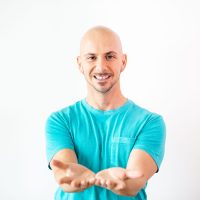View this post on Instagram
Yoga appeared at a time in my life when I was trying to define who I was.
In early 2001, I decided to leave everything I knew behind in Argentina and move to the United States. Within weeks of arriving in Miami, I took my first yoga class, and within a few years I signed up for a teacher training.
Through yoga, I learned to see myself not as a failure but as an unfinished work that is always in progress.
Yoga isn’t some universal panacea that wards away all troubles. On the contrary, I’ve dealt with more difficult things than I could ever have possibly imagined: unbearable grief, severe depression, and things falling apart in unexpected ways.
After losing my mom, I continued teaching postural yoga, but the grief and sorrow that stayed with me made me more empathetic to those experiencing difficult life situations.
I was no longer satisfied with just being a good yoga teacher. I felt a calling toward making my work more meaningful, a calling that needed to be answered and put into action.
Yoga, I came to understand, is not about the physical practice per se. It’s about the understanding that deep within ourselves there is, and always will be, potential. And being a teacher is having a small role in helping others to see that.
I began to dive into yoga from new angles. Because of my own struggles, I started to explore a more therapeutic approach to yoga for mental health, trauma, and addiction. And as I was dealing with my own trauma, I became a student again. In learning how to help others, I learned how to help myself.
I traveled the country and taught weekend programs on therapeutic yoga for various nonprofits. I became an advocate of yoga for mental health, and in 2017 I wrote a piece coming out as a yoga teacher who has struggled with a major depressive disorder. To this day, I still get messages from students and readers saying how liberating it was to read that article and how much they identified with it.
I learned a new approach to the practice that was less postural and more experiential and offered to all of my students the opportunity to be in charge of their own practice instead of trying to fit them into the mold of a particular kind of practice.
I started to volunteer at a nearby women’s homeless shelter, and connected with a new demographic of people who often struggle to know where the next meal for them and their children will come from. But to my surprise, they too benefited from the practice of breath, mindful movement, and the connection with someone that would look at them in a loving way. Through my work with these underprivileged populations, I came to understand some of the deepest teachings of yoga in a way that no amount of physical practice could possibly teach me.
I extended my teaching to medical residents at the hospital, who suffer some of the highest rates of burnout, depression, and even suicide of any profession. Although they are a completely different demographic from the homeless and to some extent might appear from the outside to be privileged, they are also struggling, suffering, and in need of ways of coping with the unreasonable pressures and stress placed upon them. Through working with those who are our primary caregivers, I came to understand the meaning of the saying, “Be kind, for everyone you meet is fighting a hard battle.”
I also began teaching at prisons, where I saw what a real lack of freedom and dignity looks like. I felt humbled and compelled to help those who are abandoned behind bars to regain a sense of hope through movement, breath, and connection. I learned that some of those who are considered the worst of society may have the brightest light inside them. We are all looking for redemption in some way. Through my work with the incarcerated, I understood that the practice has no bars, barriers, limitations—and when the intention is pure, even those who are forgotten by society can find hope and strength to keep going.
I also started teaching at middle schools. In some way, this feels like coming full circle. I see my younger self reflected in those teens who are struggling to find their voices and identities, to find comfort and peace in a constantly changing body and world.
In my experience, yoga and all the different wellness modalities and healing practices that make us feel better have opened a channel to be of service to those in need, and ultimately be kinder to myself, more compassionate, and more clear about why I am in this world.
Lately, as I continue teaching to all these different demographics—high-end yoga studios with affluent clientele, homeless shelters, hospitals, prisons, and schools—I practice seeing and nurturing that potential within each human being, no matter what their outer circumstances may look like. I try to help them to express their feelings through movement and to navigate the responsibilities upon their shoulders with yoga, meditation, and breathing practices.
In return, they look back at me, and remind me that every choice I made was worth it. They remind me how lucky I am to live a life of service to others, for this alone brings genuine meaning to our lives.
~











Read 3 comments and reply